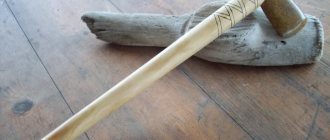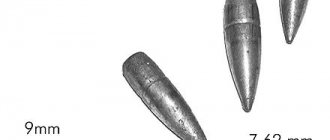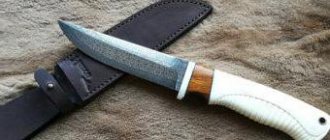All fans of active outdoor activities know how important comfortable, light, and high-quality equipment is when hiking. After all, it depends on him how pleasant the trip through the mountains will be. Moreover, we are talking not only about a tent, sleeping bag, backpack and other personal equipment, but also about tools that may be needed on a hike. So, when planning a trip to the mountains, you should definitely think about such an item as a tourist ax.
Types of axes
It is worth noting that there are quite a lot of types of axes, but not all of them can be used as a tourist axe. And, in order to avoid mistakes when preparing for a hike, you need to know what types of axes exist, how they differ from each other, and which one you need. The most popular are the following:
- Carpentry. They are small in size and weight and are used for fine woodworking. In this case, their blade must be very sharp.
- Lumberjack. It is equipped with a long handle, a wide blade and is used when cutting down trees.
- Cleaver. Its working part is cone-shaped and heavy, which makes it easier to split large logs.
- Universal carpentry. Its weight can vary from 600 g to 1.4 kg. The handle of this ax is relatively small. It is used for ordinary “rough” woodworking.
- Ice ax This tool is necessary for climbers to climb high mountains covered with snow and ice. Outwardly it looks like a pickaxe.
- Tourist. It is distinguished by its low weight, shortened handle and small blade. This ax usually comes with a case, which makes carrying the tool safer.
Ice ax and tourist ax are the types of axes that may be needed when hiking in the mountains. However, the first one is only needed in the case of mountaineering. The second one is necessary for both climbers and simply tourists who love to travel through the summer mountains.
Ax on a hike: why is it needed?
On a mountain hike that involves at least one overnight stay, a tourist ax is simply an irreplaceable thing. First of all, thanks to it, you can chop wood for a fire, with which you can cook food, keep warm, or just sit in a large group near it, talking about various topics. In addition, the ax will come in handy when you need to cut pegs to stabilize the tent or create a canopy when it rains.
It is also worth mentioning the possible protective function of this tool. Of course, do not think that you can rush at a bear or wild boar with an ax, but situations can be different, and sometimes it can save your life.
Why do you need a hatchet on a hike?
The first thing that comes to the mind of an inexperienced tourist is preparing firewood for a future fire pit. But a camp hatchet will help in a number of other cases:
- setting up a tent;
- creation of dryers and awnings;
- working with kitchen utensils;
- lighting and maintaining a fire.
Having arrived at the place of deployment, one of the first tasks of the traveler is to set up a tent. In this case, the hatchet is used to make stakes if they are not available. You can also use a tool to hammer them into the ground (carrying a hammer with you is not very convenient).
For camping and comfortable recreation, care should be taken to improve the territory. Here you need to cut down excess branches and bushes, level the area, and prepare a place for drying dishes and towels. And all this can be done with an axe. If necessary, he will help open canned food, as well as cut up caught game.
Rules for choosing a tourist ax
As you already understand, it is important that the tourist ax performs the main function of this tool, that is, it chops well. And for this, it must have a number of characteristics, which the tourist making a purchase should pay attention to.
So, you should start with the weight of the axe. Of course, modern manufacturers have done a lot to make this travel tool as light as possible. But still, in order for it to perform its function well, its weight cannot be less than 600 g. The only exceptions are small tourist axes, which are intended only for cutting pegs and chopping small knots.
You should also pay attention to the ax handle. It is best when birch is used for its manufacture - it is at the same time hard, elastic and light. Plastic is often used for the handle of a tourist ax - its main advantage is its low weight, but in this case it is important that such an ax is covered with rubber. Otherwise, working with the tool will be inconvenient. As for the shape of the handle, its end should be thickened, and there should be a slight bend in the middle.
When buying a camping axe, check it as follows: grab the tip of the handle with two fingers and lightly hit the corner of the blade - you should hear a fairly long and clear ringing, otherwise you should not hope for high-quality metal. In addition, it is necessary to carefully inspect the blade - there should be no forging defects.
How to choose a tourist ax?
An ax is the most important tool in the arsenal of a builder, home craftsman, and any tourist, hunter, or fisherman must have it with him. Often, a correctly selected tourist ax can not only simplify life on a hike, but also significantly increase your own safety.
For what purpose is an ax needed?
An ax can be used on a hike for the following purposes:
- for making tent pegs;
- for driving in these same pegs;
- for cutting branches;
- for cutting logs to light a fire;
- for building a hut;
- for chopping sushi to use it in a fire, etc.
What was said above about ensuring one’s own safety can be explained as follows: there are many cases told when hunters killed a bear with an ax. But if you remember, earlier it was the ax that was a weapon and a tool of labor. With the help of an ax and a stake they killed it, and they went after the beast. Therefore, such a statement is completely justified. Not a single hunter or fisherman goes into the forest without an ax. In addition, a headlamp , which will illuminate the path of movement and allow you to see better at night.
It can be noted that in addition to an ax, hunters and tourists need to take with them a folding tourist knife , which will allow you to open a tin can, trim branches, and make notches on a tree. In order for an ax to serve its owner for a long time, it is necessary to choose it correctly.
How to choose the right ax?
First of all, it is important to determine what the ax will be used for. Of course, it is clear that on a hike it will not be used to build a house, but you need to clearly understand the purpose of its use in order to choose exactly the model that is most suitable for the upcoming conditions of the hike.
The cutting part of the ax must be made of high quality steel. In this case, the product will become less dull, which means it will need to be sharpened less often. The service life of such a tool will be quite long. To check the quality of the steel of the cutting part, you need to take the ax by the handle and use your fingernail to make a sharp click on the cutting part. The sound should be ringing, lingering, dense, which will indicate the density of the metal of the blade. If the sound quickly subsides and is dull, then this indicates insufficient density of the metal. Such an ax will need to be sharpened frequently, and it will develop nicks even when the blade hits a knot.
The weight of the ax is selected individually, that is, taking into account the work that will be performed by this tool. For cutting off small branches, a tool that is light in weight is suitable. Axes from the medium weight category are suitable for carpentry. And heavier axes are used, for example, for chopping huge workpieces.
To work comfortably with wood, the ax blade must be straight. You must know how to handle an ax with a curved blade (such as Finnish axes).
The ax handle can be made of plastic or wood. The best material for an ax handle is birch, which is the highest grade. A significant disadvantage of a wooden handle is its gradual drying out, which leads to the blade falling off the handle. In this case, you need to lower the ax into the water or drive a wedge. The plastic handle does not have this drawback, which is why such an ax will cost more, but will also last longer.
The online store “On the Seven Winds” presents Fiskars axes, which, although they are quite expensive, are of high quality. In addition, their handles are rubberized, which prevents your hands from slipping. Among our range of recreational products you can choose everything you need for a hike: a tent, cold accumulators for thermal bags , sleeping bags, rugs, etc.
Travel Tool Sets
An ax is not the only tool you may need on a hike. And if you want to always have everything at hand during your trip, then you need to purchase a whole travel set. It is worth noting that multitools are very popular among modern tourists, because they contain all the necessary tools: a corkscrew, a knife, a can and bottle opener, a spoon, a fork, an awl, scissors, mini-saws, pliers, screwdrivers and much more.
A very convenient travel set consisting of a knife, saw, shovel and axe. Moreover, for the last two tools one handle is often used, which significantly lightens the overall weight of the set. It is also convenient that the saw and knife are often hidden in the same handle, and then everything is folded into one case. Such sets are very convenient due to their compactness, versatility and light weight.
Advantages and disadvantages of Fiskars tourist axes
The Fiskars tourist ax has already become a favorite among many travelers. After all, it has numerous advantages, including ease of use, durability, high-quality sharpening of the blade using unique technology, durability, high performance, and low friction force.
However, along with all the above advantages, Fiskars chopping tools, including the X7 tourist axe, also have a drawback. We are talking about the handle with which they are equipped. It is believed that the material used for its manufacture is less reliable even compared to axes made of wood such as oak or hornbeam, not to mention birch.
Reviews of Fiskars tourist axes. Prices
During the existence of the Fiskars company, many hiking enthusiasts have already acquired a tourist ax produced by it, and accordingly, everyone has formed their own opinion about it. Summarizing the huge amount of information provided by numerous users, a number of conclusions can be drawn. Most tourists praise the lightness and high-quality sharpening of Fiskars axes. They also mention the ease of working with this tool. A nice bonus for travelers is the presence of a cover, so you can forget about possible dangers when carrying it in a backpack. There are some negative reviews as well. Some tourists mention that Fiskars is not a “Soviet” ax, and therefore an unsuccessful hit on a stone instead of a log can cost the whole blade.
As for the prices for tourist axes from this manufacturer, they depend on many factors, including weight, size, and possible additional functions. The cost of the instrument ranges from 2 to 5 thousand rubles.
content .. 11 12 18 ..Axes for hiking
An ax is a must-have piece of group equipment on any hike. It is best to take a real carpenter's ax for a hike. It's quite versatile. When preparing for a hike, you need to see if he is in order. First of all, the ax should not have nicks or burrs and be well sharpened. Rough sharpening is done on an emery wheel, and then the point is fine-tuned using a whetstone and a whetstone. Anyone who does not know how to do this himself should take the ax to a workshop. In this case, you should warn the master that the ax is needed for cutting down trees, and not for carpentry. The fact is that for carpentry work the ax blade is sharpened very finely. When chopping wood when hitting strong
knots on the blade can easily cause large nicks and the ax will fail.
Next, you need to see if the ax is well seated on the ax handle. Very often, axes sold in stores are not dried enough, and therefore, when stored at home for a long time, a once well-mounted ax often begins to “walk” on the axe. It is not safe to work with such an ax. It must be wedged by driving a wooden or metal wedge into the end of the axe. The direction of wedging is selected according to the direction in which the ax hangs. The wooden wedge needs to be made of dense, dry wood and not very tightly trimmed so that it does not come back out. In this case, it is necessary to ensure that the mutual position of the ax and the ax handle is not disturbed. What do you mean by this? Typically, a carpenter's ax is mounted in such a way that, when placed on the blade, it raises the heel of the ax about two fingers above the plane on which it stands. If the ax handle is long (for example, 60-70 cm instead of the usual 50 cm), then it is quite acceptable for the heel of the ax to drop lower or even touch the plane on which the blade stands. But we must not allow it to be high above this plane. In addition, you need to make sure that the ax is not tilted to the side. To evaluate this, you need to bring the inverted ax to your eye and see whether both ends of the blade and the heel of the ax lie on the same straight line (Fig. 5). If they lie, it means the ax is planted correctly, if not, it means it’s planted incorrectly.
If the fact that the ax does not fit tightly on the ax handle only became clear on the eve of the trip, when it is already too late to wedge, it needs to be placed in water overnight. Overnight the wood will swell and the ax will fit much tighter. You just need to remember that soaking the ax is a temporary measure. As soon as the ax handle dries, the ax will begin to swing on it again.
Rice. 5. Ax head: a - correct; b - wrong..
Rice. 6. Case for an axe.
To be carried in a backpack, each ax must be sheathed1. A cover can be made by folding a piece of thick leather or canvas in half and sewing or riveting it around the edges. Such a cover is held on the ax with the help of an elastic band sewn in the middle (Fig. 6). You can make a cover from a piece of hose with walls 2-3 mm thick. A longitudinal incision is made on it, not reaching 2-3 cm to the edges. The ax blade is inserted into this cut. This cover is held on the ax with the help of an elastic band placed over it.
You can make a case similar to those in which all-metal hunting hatchets are sold. It is more beautiful than the primitive cases described above, but, perhaps, less convenient. At the bivouac, when the axes are taken out of their cases, young tourists for some reason usually throw the cases on the ground and remember about them only the next day.
As a result, one or two cases are missing. A firm rule should be established: the case removed from the ax is always placed in the same place, the most convenient place is in the pocket of the backpack in which the ax was carried.
The issue of using small hatchets on a hike is controversial. Even experienced tourists have differing opinions on this issue. Some people think that small hatchets are of no use at all on a hike (you can’t work with them properly, which means there’s no need to take them). Others believe that they can get by with them alone. In practice, everything depends on the conditions in which the hike takes place. On a big trip, of course, you can’t get by with small axes. Here they usually take axes at the rate of one for three people and, as a rule, only large ones. Only sometimes one of these axes is replaced by a small one. Experienced hikers usually get used to their ax and take it with them even on Sunday hikes. On the other hand, on a one-day hike in the hot summer, when it is unlikely that you will have to chop anything other than brushwood, large axes are not necessary. On such trips they take axes at the rate of one for 4-5 people and, indeed, they often make do with only small ones. That's why,
When traveling for young tourists, it is probably best to take both axes in some proportion. The more difficult the hike, the more large axes you need to take; the simpler it is, the more small ones.
Many prejudices against using small hatchets on a hike are based on the fact that commercially available hatchets are often of poor quality. The so-called all-metal hunting hatchets with a rubber handle have proven themselves better than others. Although experienced travelers see shortcomings in them, this is, perhaps, the only type of small ax that can be unconditionally recommended to young tourists.
content .. 11 12 18 ..











